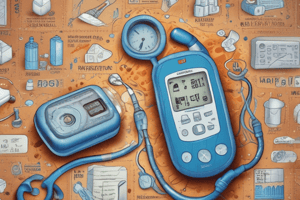Podcast
Questions and Answers
What is a significant challenge in developing countries regarding insulin dosing?
What is a significant challenge in developing countries regarding insulin dosing?
- High cost of insulin
- Lack of healthcare provider knowledge on insulin use
- Patient reluctance to insulin initiation
- Limited availability of insulin (correct)
Why may physicians not aggressively promote insulin to patients?
Why may physicians not aggressively promote insulin to patients?
- Due to the high cost of insulin
- Due to the complexity of insulin regimens
- Because of the lack of glycemic targets
- Because patients are already taking non-prescription medications to lower glucose levels (correct)
What is a potential consequence of patients' fear of insulin regimens?
What is a potential consequence of patients' fear of insulin regimens?
- Improved glycemic control
- Reduced financial burden
- Impaired quality of life or hypoglycemia (correct)
- Increased quality of life
What would be useful in achieving insulin dosing according to the text?
What would be useful in achieving insulin dosing according to the text?
Why is it important to tailor insulin dosing to individual or population needs?
Why is it important to tailor insulin dosing to individual or population needs?
What is a barrier to insulin initiation in developed countries?
What is a barrier to insulin initiation in developed countries?
What is a significant barrier to achieving good glycemic control?
What is a significant barrier to achieving good glycemic control?
What is the primary goal of insulin dosing in diabetes management?
What is the primary goal of insulin dosing in diabetes management?
What is the most significant adverse event resulting from poor insulin dosing?
What is the most significant adverse event resulting from poor insulin dosing?
What is the current challenge in insulin dosing?
What is the current challenge in insulin dosing?
What is the correlation between the level of glycemic control and the risk of developing diabetes-related complications?
What is the correlation between the level of glycemic control and the risk of developing diabetes-related complications?
What is the effect of a 1% reduction in A1C on the risk of microvascular complications?
What is the effect of a 1% reduction in A1C on the risk of microvascular complications?
What is the primary challenge in achieving good glycemic control in patients with diabetes?
What is the primary challenge in achieving good glycemic control in patients with diabetes?
What is the importance of controlling post-prandial glucose in diabetes management?
What is the importance of controlling post-prandial glucose in diabetes management?
What is the role of diabetes educators in diabetes management?
What is the role of diabetes educators in diabetes management?
What is the current trend in educational resources for general practitioners and patients about insulin?
What is the current trend in educational resources for general practitioners and patients about insulin?




